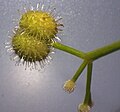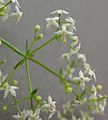Meadow bedstraw
| Meadow bedstraw | ||||||||||||
|---|---|---|---|---|---|---|---|---|---|---|---|---|

Meadow bedstraw ( Galium mollugo agg.) |
||||||||||||
| Systematics | ||||||||||||
|
||||||||||||
| Scientific name | ||||||||||||
| Galium mollugo | ||||||||||||
| L. |
The meadow bedstraw ( Galium mollugo ), also called small meadow bedstraw , white forest straw , grass star or common bedstraw , is a species of the red family (Rubiaceae). Together with Galium album it forms the species group Galium mollugo agg. This is widespread and a common plant in Central Europe that thrives on sunny meadows, pastures and on paths with nutrient-rich, loamy soils.
Similar species
The meadow bedstraw ( Galium mollugo ) and the white bedstraw ( Galium album ) are two closely related species that are often confused with one another. But they have different numbers of chromosomes. Galium album has 2n = 44, Galium mollugo 2n = 22. Both together form the species group Galium mollugo agg. Since Galium mollugo is much rarer in Central Europe than the common Galium album , every statement about Galium mollugo must first be checked to see whether it also applies to this special species. In general, the term meadow bedstraw can only refer to the species group.
Locations and distribution in Central Europe
The meadow bedstraw needs nutrient-rich, fresh clay soil.
It is a kind of moist, nutrient-rich forest and forest fringing community, also of mountain meadows. Since it is less tolerant of shade, it prefers light stands, as well as edge and clearing areas and fat meadows; it is seldom found in light floodplain forests. In the Allgäu Alps, it rises in the Tyrolean part between Dürnau ( Reutte municipality ) and Vorderer Mutte up to an altitude of 1,800 meters.
description
The meadow bedstraw grows as a deciduous, perennial , herbaceous plant that can reach heights of up to 1 meter. On the bare, square stem they carry leaf whorls, which usually consist of eight lanceolate single leaves that are sharp on the edge. On the leaf whorls, secondary branches branch off from the main stem.
The flowering period extends from May to August. At the tips of the main and secondary stems there are grape-shaped inflorescences with around 1 to 1.5 cm small, four-pointed white flowers . In contrast to the white bedstraw ( Galium album ), the meadow bedstraw has flowers with a diameter of 2 to 3 mm, the stems of which are 3 to 4 mm long. The stems are square, smooth, mostly branched. Its fruit stand is loose due to the strongly spreading stems. In winter, the stem plant is often brown-red due to protective pigments.
The pollination is done by kurzrüsselige insects, especially by bumblebees .
The fruits are mostly spread randomly by grass eaters.
use
The roots of Galium mollugo agg. used to make red dye for textiles, similar to the roots of the madder . The plant contains the enzyme rennet , which is also found in the calf's stomach and is used in cheese production . In agriculturally used meadows, meadow bedstraws are fought because hay, which contains too much meadow bedstraws, is spurned by cattle.
Use in the kitchen
Meadow rennet can be used in many ways in the kitchen. The young leaves, which are used raw and cooked, are tasty in spring. The taste is reminiscent of a mixture of rocket and lettuce. They are used for pestos, salads, smoothies, soups and sauces. The white flowers, which have a sweetish to honey-like scent, can be collected from May to September. They can be used to decorate dishes and flavor beverages or processed into jelly, syrup and desserts. The seeds ripen in August and September, and when roasted they are an aromatic substitute for coffee.
Images of Galium mollugo agg.
Common names
For the meadow bedstraw , the other German-language trivial names exist or existed : Butterstiel ( Tübingen ), Gliedekraut ( Silesia ), Grasstern, soite Klei ( Göttingen ), Bedstraw , Liebfrauenstroh ( Carinthia ), Littgangche ( Eifel near Nürburg and Altenahr ), Megerkraut , Oarkreutl ( Tyrol in Pinzgau ), wild redness, narrow star and starwort (Silesia).
literature
- Dietmar Aichele & Marianne Golte-Bechtle: What is blooming there? , 54th edition, Kosmos Verlag 1991.
- Meadow bedstraw. In: FloraWeb.de.
- Ruprecht Düll , Herfried Kutzelnigg : Pocket dictionary of plants in Germany and neighboring countries. The most common Central European species in portrait. 7th, corrected and enlarged edition. Quelle & Meyer, Wiebelsheim 2011, ISBN 978-3-494-01424-1 .
- Dietmar Aichele, Heinz-Werner Schwegler: The flowering plants of Central Europe , Franckh-Kosmos-Verlag, 2nd revised edition 1994, 2000, Volume 3, ISBN 3 440-08048-X
- Oskar Sebald, Siegmund Seybold, Georg Philippi, Arno Wörz (eds.): The fern and flowering plants of Baden-Württemberg. Volume 5: Special part (Spermatophyta, subclass Asteridae): Buddlejaceae to Caprifoliaceae. Eugen Ulmer, Stuttgart 1996, ISBN 3-8001-3342-3
Individual evidence
- ^ Erich Oberdorfer : Plant-sociological excursion flora for Germany and neighboring areas . With the collaboration of Angelika Schwabe and Theo Müller. 8th, heavily revised and expanded edition. Eugen Ulmer, Stuttgart (Hohenheim) 2001, ISBN 3-8001-3131-5 , pp. 766 .
- ↑ a b Erhard Dörr, Wolfgang Lippert : Flora of the Allgäu and its surroundings. Volume 2, IHW, Eching 2004, ISBN 3-930167-61-1 , p. 514.
- ^ Bavarian State Research Center for Agriculture: Edible wild herbs: Meadow rennet (PDF; 235 kB). Retrieved December 3, 2015
- ^ Federal Center for Nutrition: Meadow rennet . Retrieved April 29, 2020.
- ^ Georg August Pritzel , Carl Jessen : The German folk names of plants. New contribution to the German linguistic treasure. Philipp Cohen, Hannover 1882, p. 159, archive.org






